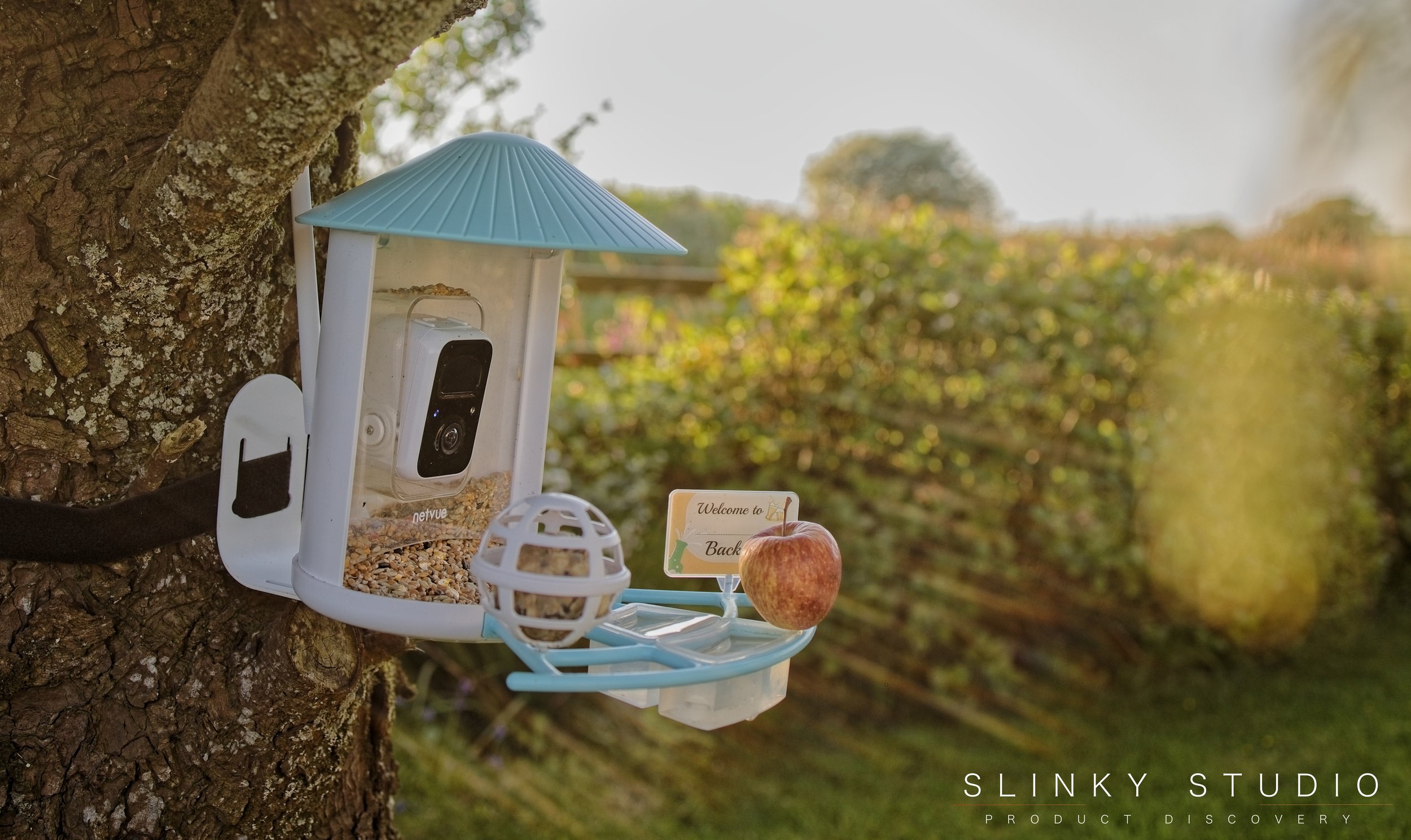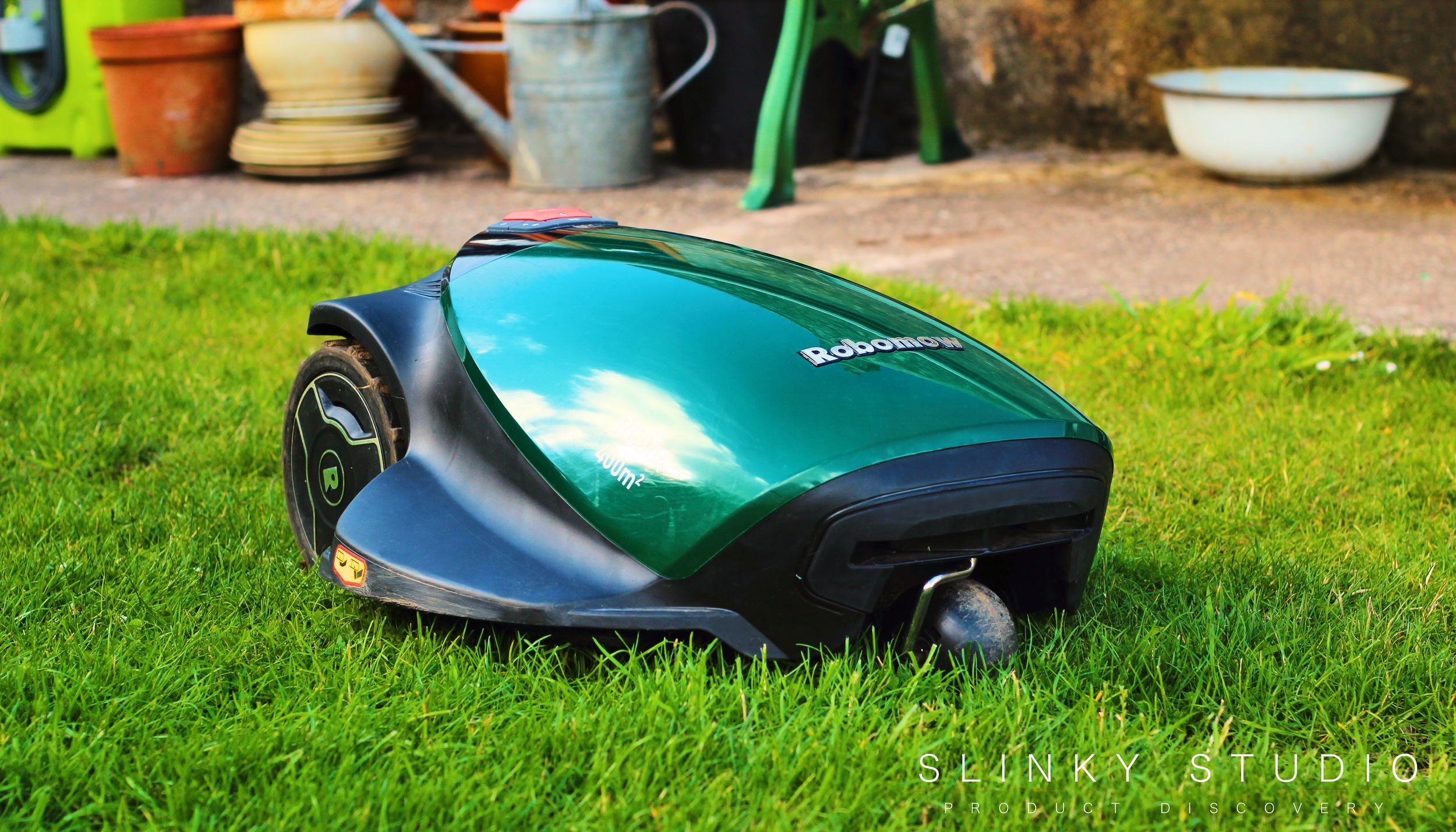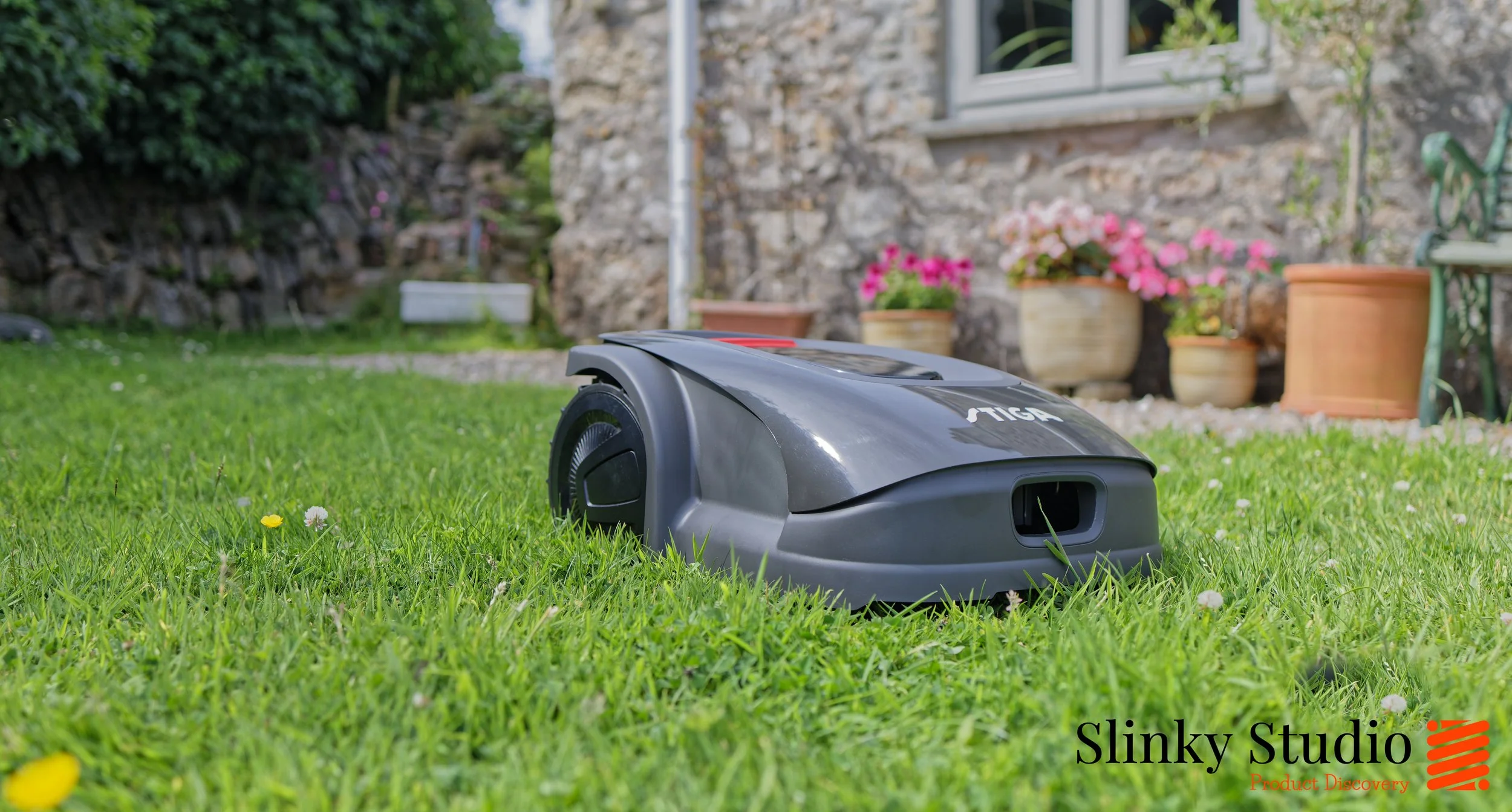Ambrogio Twenty ZR Robot Lawnmower Review
This is a different breed of robot mower, one that doesn’t require a perimeter wire like all the other models we have reviewed. It’s called the Ambrogio Twenty ZR (£1499 RRP) and it makes its own way as a fully autonomous mowing solution for lawns up to 1000m², replacing the perimeter wire with radar and a great deal of AI. It’s been put to test on some of the studio’s lawns to see just how effective and intelligent this wire-free solution is?
Design
We’ve noticed that a recent trend on the robotic scene is to relinquish the rounded form, and instead embrace a more boxy outline, as apparent with the compact (L 296 x W 453 xH 220mm) Ambrogio Twenty ZR. This robot mower features a very rational aesthetic in terms of control placement, an even 7.5kg weight distribution, handy handle rails along the top sides for easy transportation between zones, and the lower third features plastic pieces that act as combs for grass to assist in evenness of cut. It has clearly been moulded to live and work outdoors, designed for tougher terrains and larger gardens (rated to mow up to 1000m² lawns). It’s equipped with chunky grip rubber rear tyres to conquer slopes recommended up to 35%, 2 front pivoting wheels to accompany the rear drive wheels, independent front wheel suspension tilting system and solid plastic casing which has some flex. We’ve also been impressed with how well the mower has kept its clean appearance, with the black sides not becoming scratched up by our boundary granite walls so far. The white top gets all manner of colours on it from rubbing against flower petals, but this cleans easily.
Flipping the mower over reveals a 4 point solid stainless steel (18cm diameter) blade and that pleases us as it won’t rust. It is height adjustable between 25-70mm via the use of an included tool which is done by quarter turning a lug that allows the blade mechanism to be unlocked and moved up and down. A ruler is printed onto the height adjustment tool which indicates the adjustment you are making and it’s a fairly easy process.
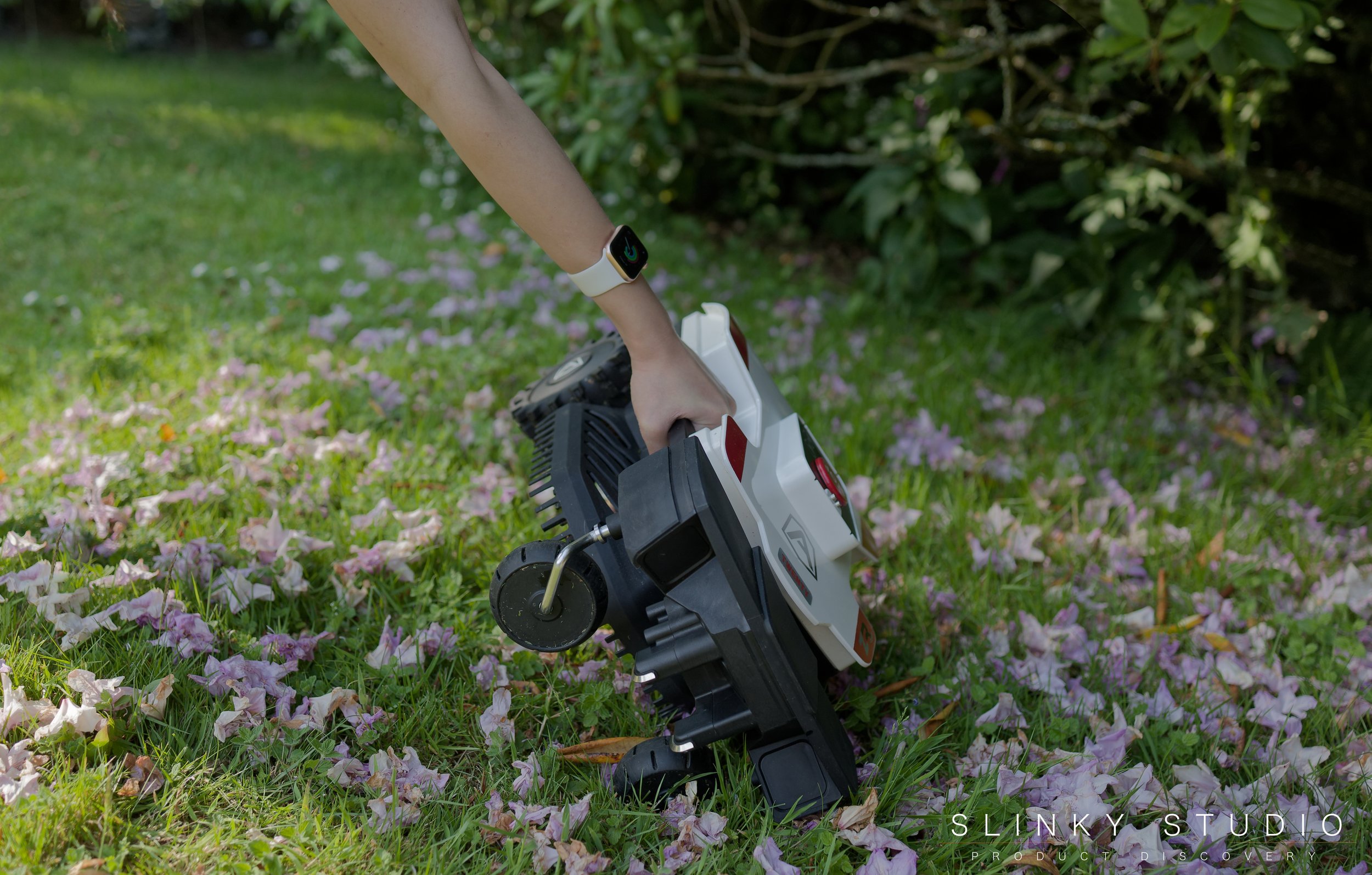
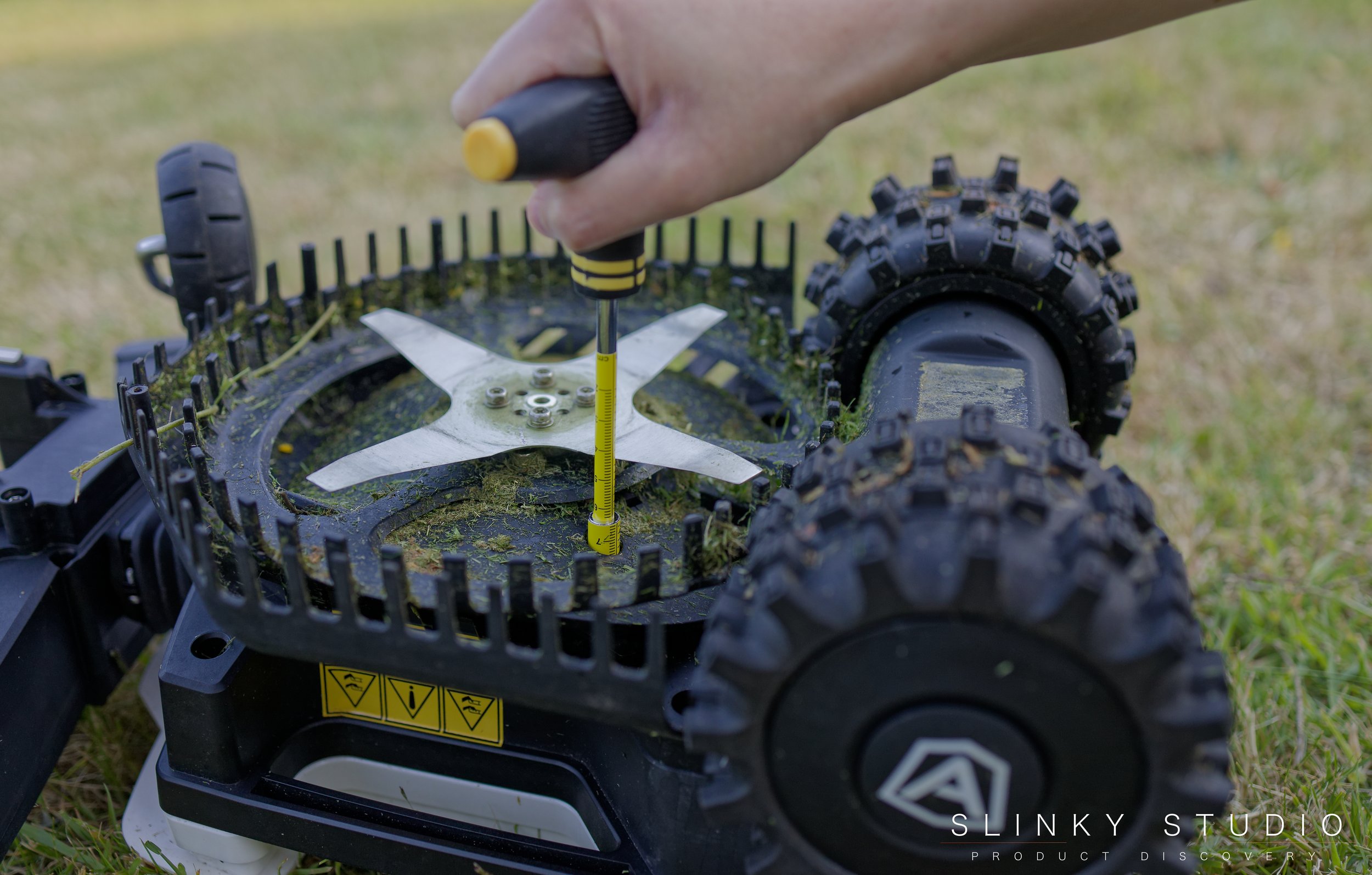

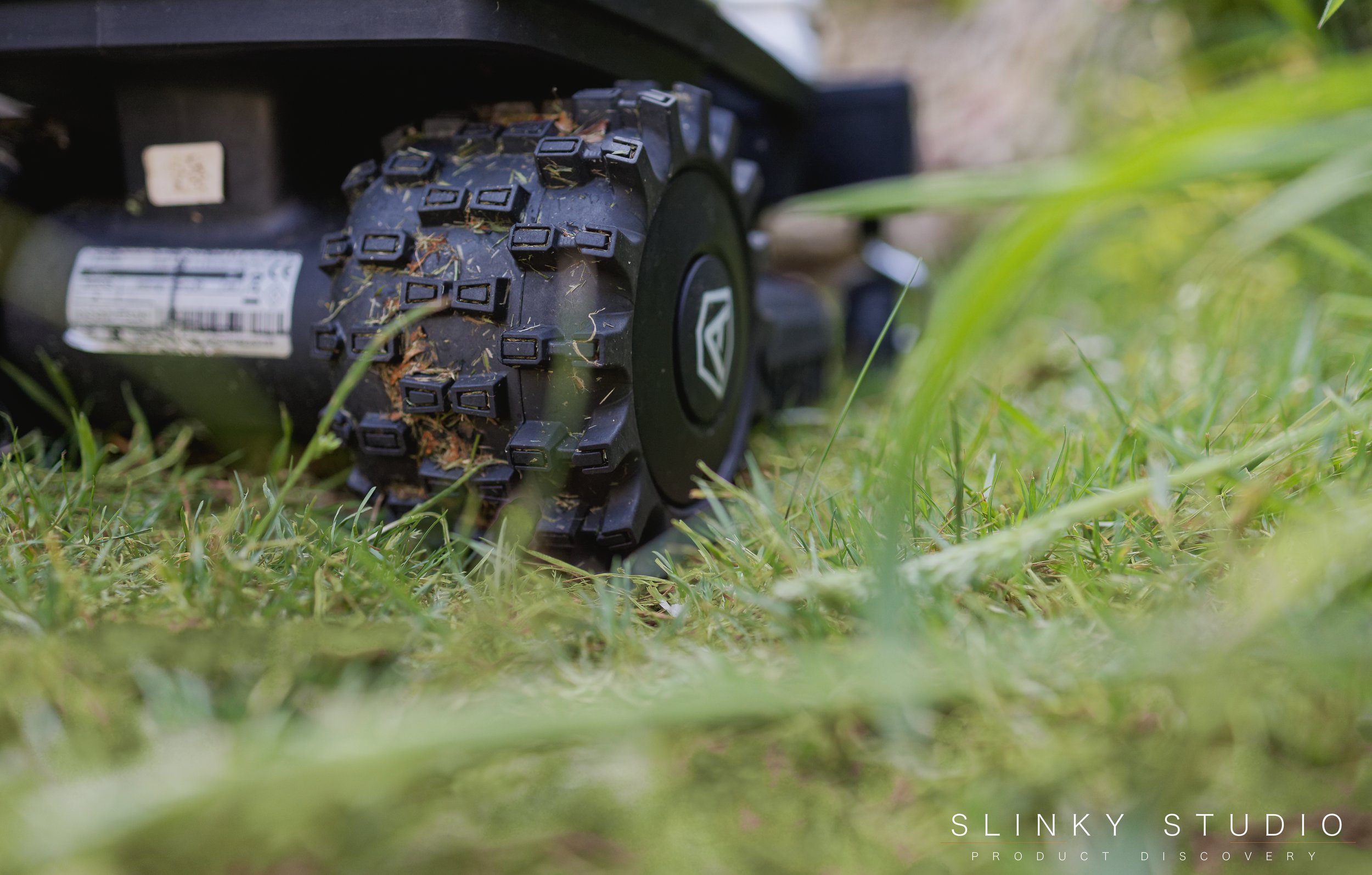
Setup
The Twenty ZR is inviting in its approach because it’s just so easy to drop into place. The most arduous part of the setup process is mounting the base station and burying a short guide wire which surprisingly does, in fact, need to be laid on the lawn toward the front of the base so the mower can find its way home for charging. Despite these initial tasks we saved a notable amount of time when compared to the robot mowers that require a perimeter wire to be measured, pegged and tested around the circumference of a lawn, which in our case, due to the the size of the first test lawn, would have taken a few hours to establish. A detailed user manual, which provides clear instructions for installation, is helpful, but the YouTube video resources on offer were found by us to be more beneficial.
The black base station is a fairly standard affair in appearance, although doesn’t feature prongs that insert into the mower as is the case with Robomow designs. Instead it has contacts that press against the mower to charge the internal 5Ah lithium ion battery (4hr runtime), with which it always managed to make contact. Ideally, as in our case, an outdoor socket is the simplest method to draw electricity to the base and charge the mower. However, since we last covered robot mowers, batteries have dramatically fallen in price per kWh and likewise small solar panel modules. It would be perfectly plausible, if you were planning on locating the base far away from the mains, to have a solar plus battery setup that would power things in the late spring to autumn period reliably.
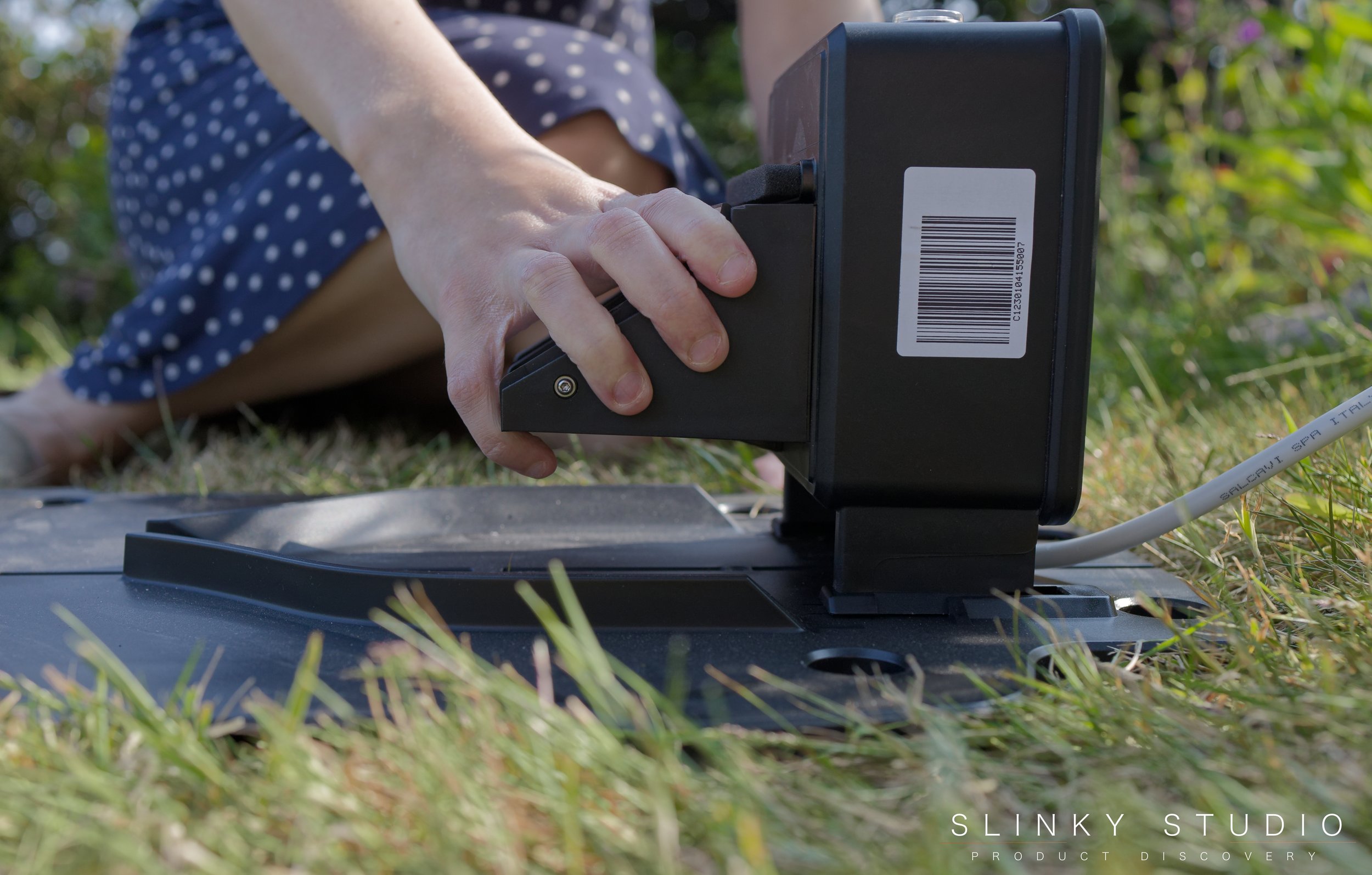
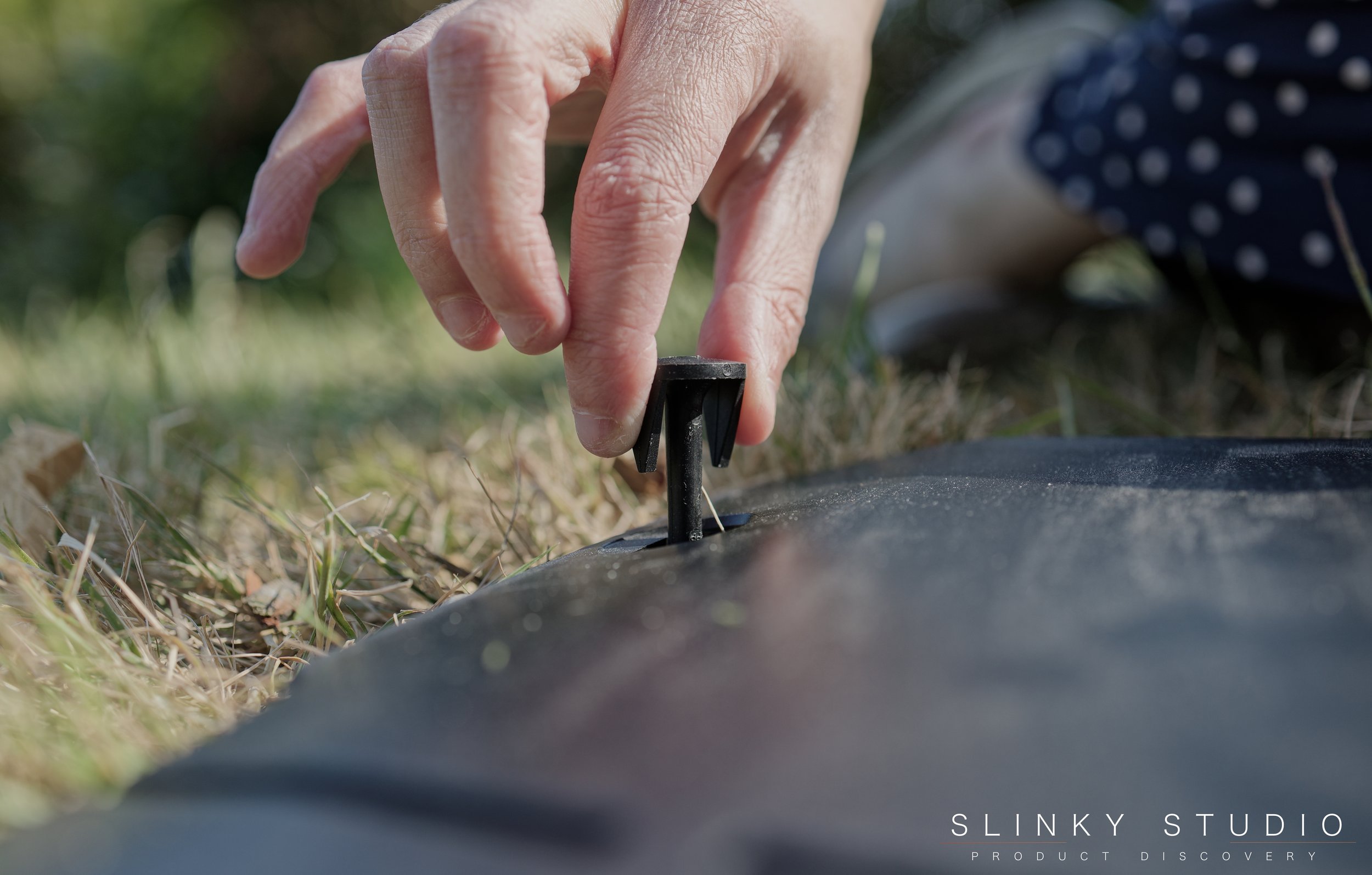

App + Onboard Controls
The Ambrogio Twenty ZR boasts a comprehensive app that is available for both iOS and Android devices. Serving as the primary setup control interface for the mower, it offers a convenient way to operate and manage its functions. Onboard controls are also available for quick access to essential features, ensuring you have control even without your smartphone nearby. The large red stop button, in particular, has proven its worth by saving at least one badminton guide wire from being entangled.
While the app provides rich functionality and useful notifications, it’s not designed to be used as constant companion. Instead more of a management styled tool and isn’t engineered to have a constant connection with your device, instead a momentary relationship. We’d prefer notifications and deeper relations, akin to so many smart devices today. Because we’re at home and in-range of the mower most of time when it's working, its app could offer a convenient user experience. But the company have decided that a reliance on Bluetooth for connectivity wouldn’t be so, when you’re away from home, checking on the mower isn’t possible as it doesn’t support Wi-Fi connectivity. However a separate GSM/GPS connect module is available as an optional accessory for £399 inc vat, but needs to be fitted by a dealer. Whilst it would be useful and we can see the benefit of having GSM connectivity that doesn’t have the range barrier of signal that our Wi-fi networks may. Although inbuilt Wi-Fi out of the box would have been brilliant, allowing consumers to choose what is best for them, but for us it would need to go hand in hand with a chained connection that was always alert. For instance in our case we have a broad Wi-Fi network that covers all our lawns and so it would be ideal.
Really the app proves most useful on an infrequent basis when nearby, allowing you to customise and monitor your lawnmower’s operation from the convenience of your smartphone. Upon initial contact with the app, a wide array of features is presented, including the ability to schedule mowing sessions based on specific days and times of the week, providing lawn information, manual control options, rain sensitivity settings that prompt the mower to retreat to its base station during inclement weather, and various nuanced settings to tailor the cutting experience to each specific lawn. Moreover, the app allows separate programming for different areas, making it a "set it and forget it" affair for maintaining multiple sections of your lawn.
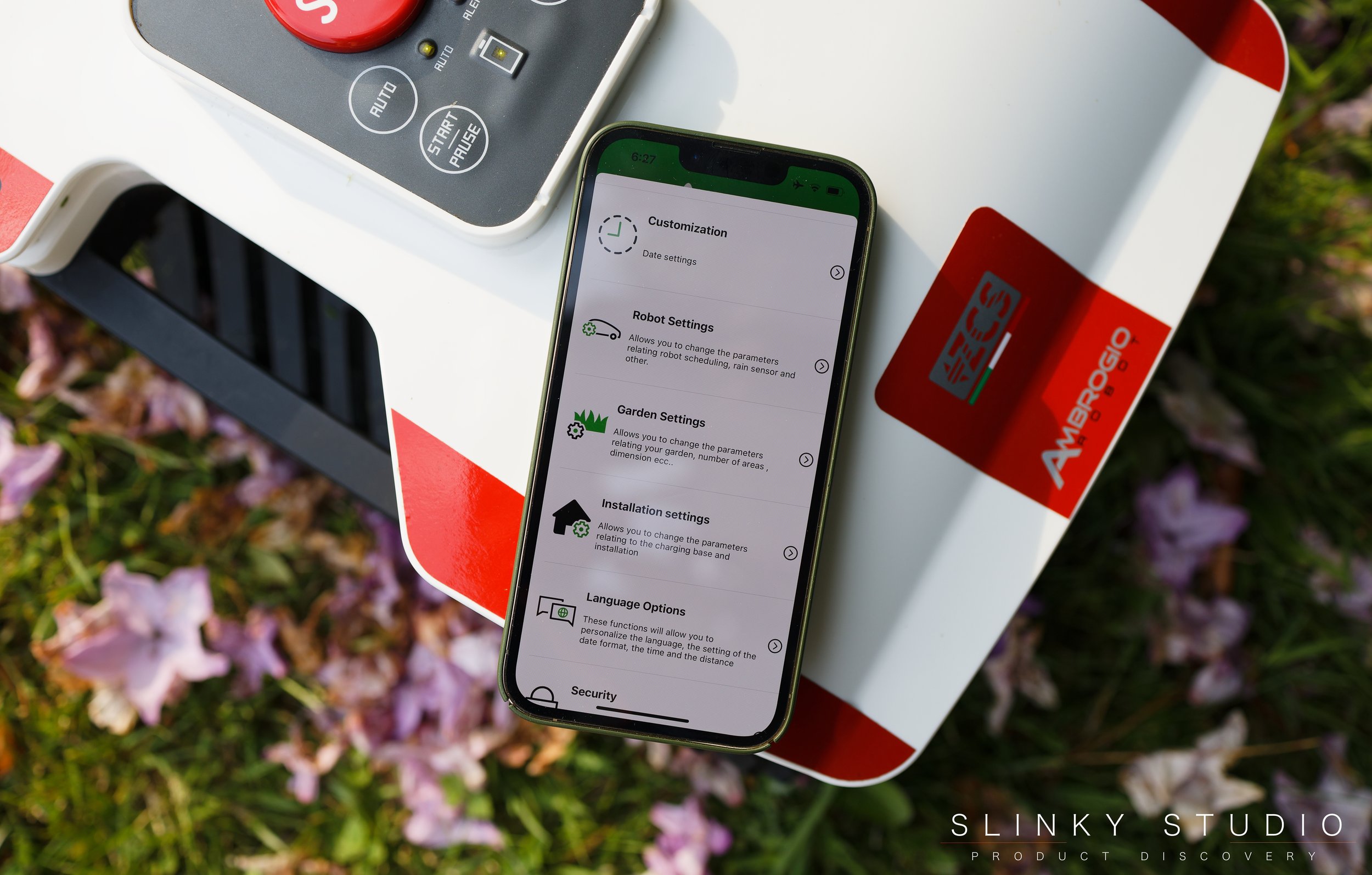
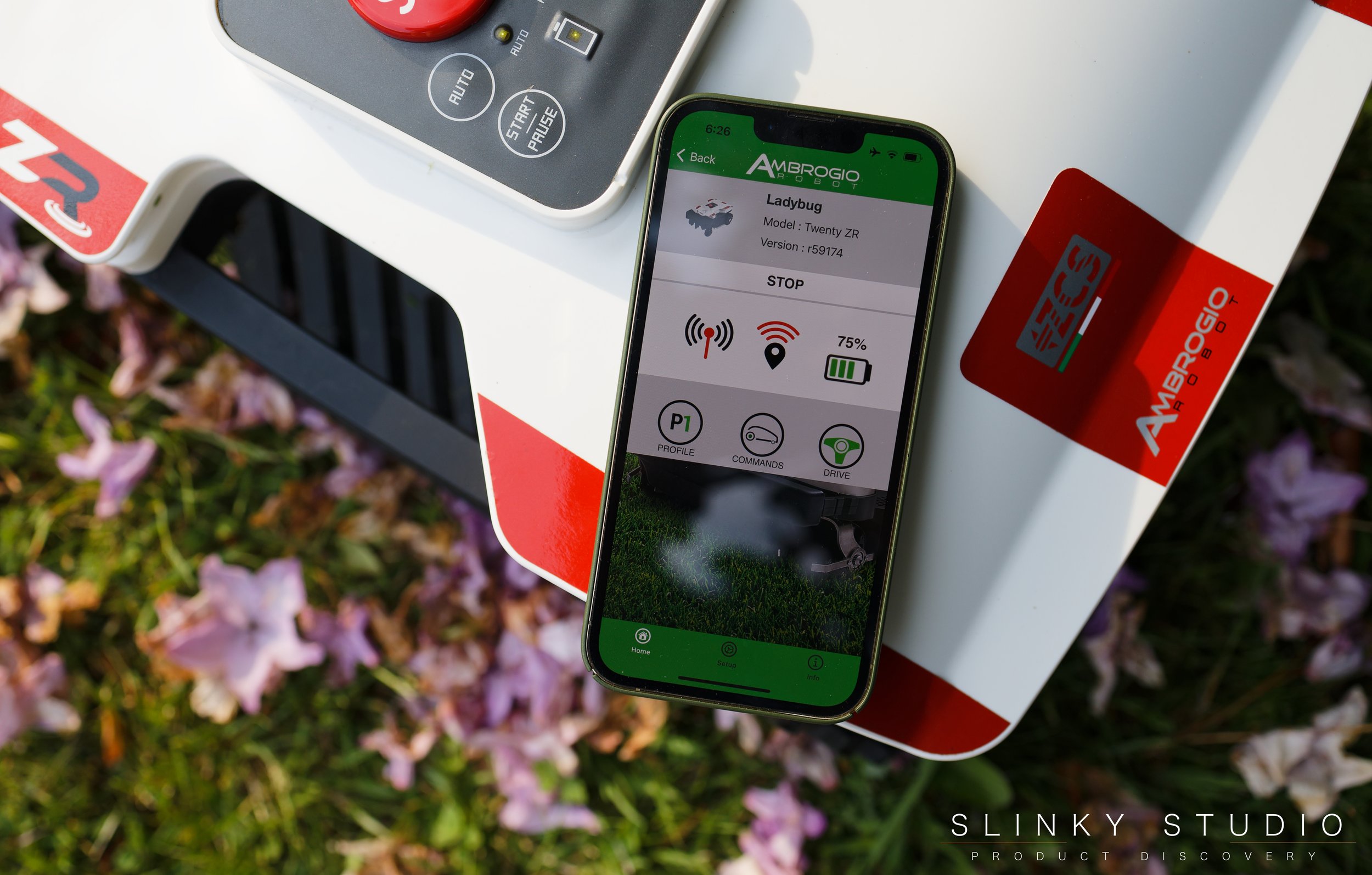
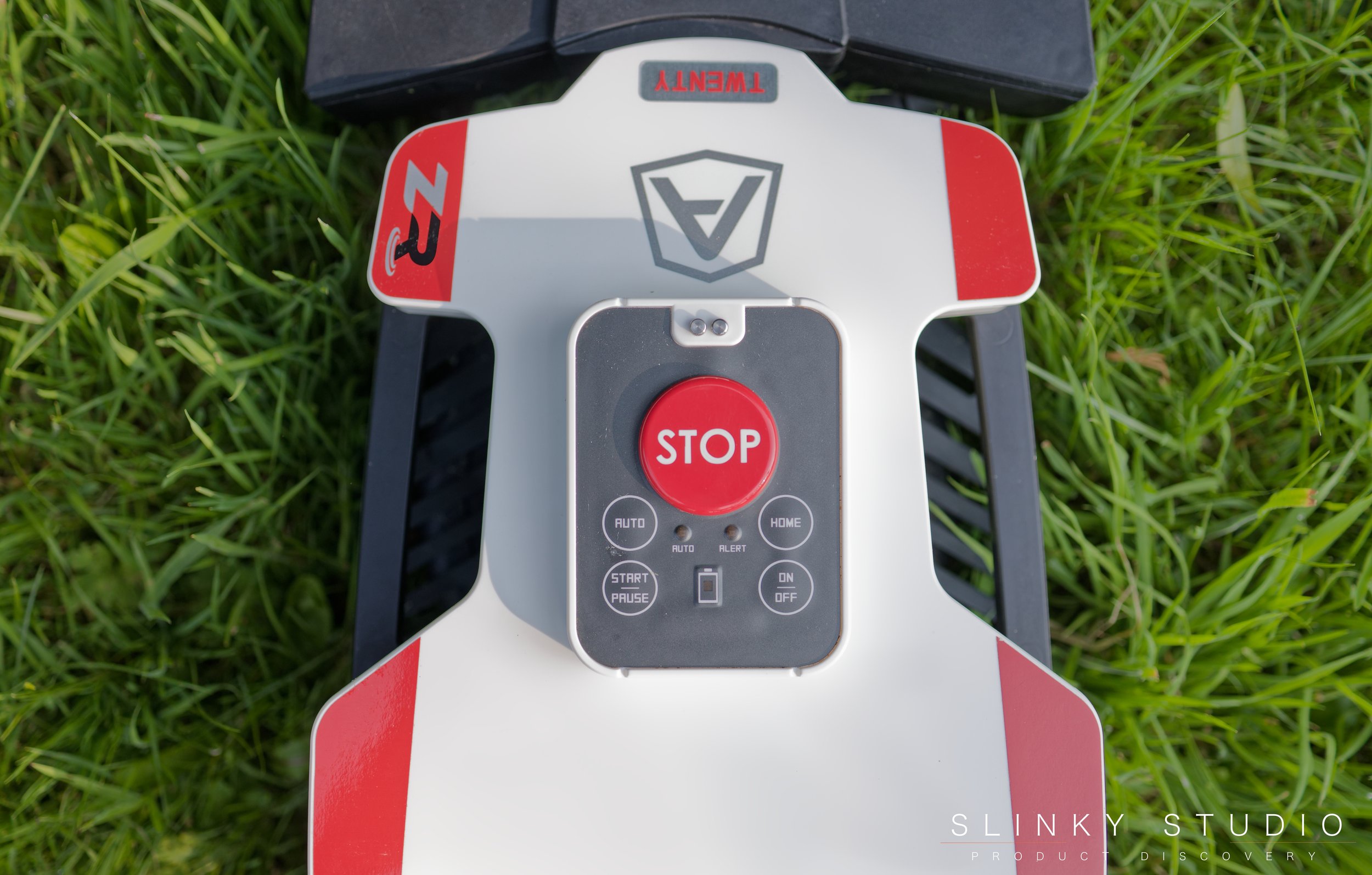
How intelligent is the automatous navigation?
There are some blatant limitations of a perimeter wire being abandoned from the autonomous Ambrogio Twenty ZR design, making it important that we made preparations prior to introducing the mower to our first and main English cottage styled lawn featuring hedges, flower beds and flat stone edging along the perimeter. However, with the second lawn we cut, we were able to just introduce the mower into place and did not need to alter a thing. Mitigating the main concern with the first lawn, we placed chicken wire around any flower beds where there were steep drops of more than 5cm. Open gaps in the shrubbery on the edges of the lawn, where weeds were present, had to be weeded and we were going to plug any holes on this sloped lawn which could catch out the wheels, but this proved unnecessary after the initial trial-run. The ZR mower is not suitable for lawns which terrace in 5cm (or 20%) drops on the edges, or where there are steps or, of course, ponds that transition from grass. You’ll find a perimeter wire robot mower necessary in such scenarios, but if there’s no grass leading to these areas and instead a clear dividing portion of surface such as decking or tiles of a minimum of 25cm in depth, it’s absolutely not an issue for the ZR.
Observing the ZR is mesmerising because of how well it handles wide ranging outdoor complexities to keep itself out of trouble. Without the need for a perimeter wire, the Twenty ZR relies on its onboard navigation system to determine its own path as it moves across our lawn. It uses radar sensors, bump sensors, a digital compass and sophisticated algorithms to differentiate between the grass and other surfaces, making informed decisions on whether to mow or navigate away. For instance, despite our main lawn having a level entrance, the Twenty ZR drives up to the edge of the lawn before it meets the pathway and then immediately turns around because of its grass recognition. The other lawn, which we didn’t need to alter at all, is walled on all sides except for one edge featuring a level gravel pathway; and this demonstrates how the ZR just ignores it every time and still cuts to the edge. The same can be said for when it’s cutting the edges of lawns where it goes underneath foliage: it skilfully stays off the soil where the lawn ends and avoids objects within lawns like standing wooden bird houses, garden lights and established plants/flowers.
So our initial peak of anxiety as to just what the Ambrogio Twenty ZR would get up to left to its own devices, quickly dissolved into a confident disinterest as its ability to navigate and adapt to its surroundings showcased an exceptional intelligence and ensured a consistent mowing experience, even with challenging landscapes with complex borders and objects within the lawn itself. In terms of a value proposition the ZR is no more expensive than its Ambrogio wired counterpart, which is quite surprising and leaves the decision of what is best for your lawns an easier one to make.
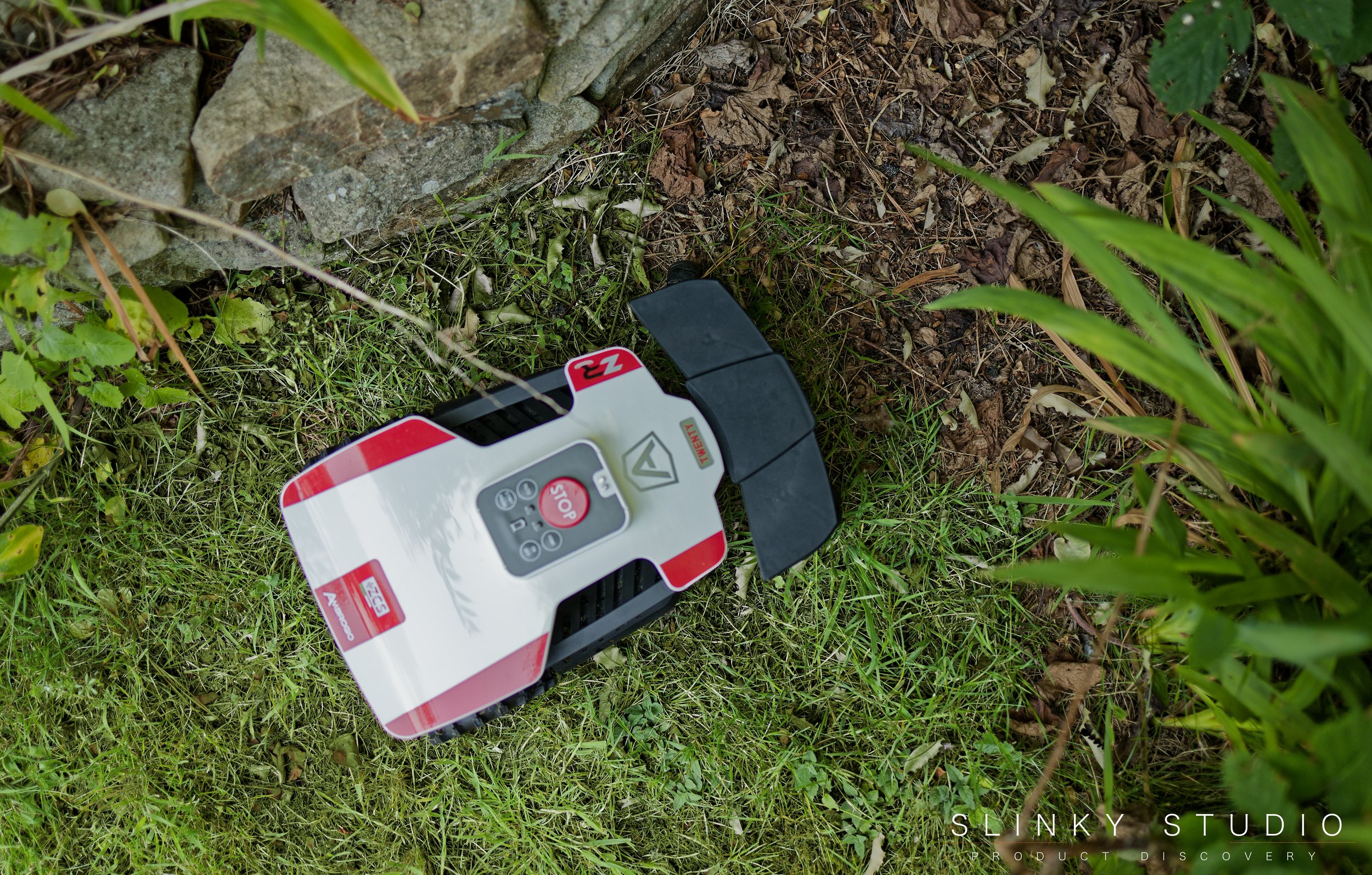
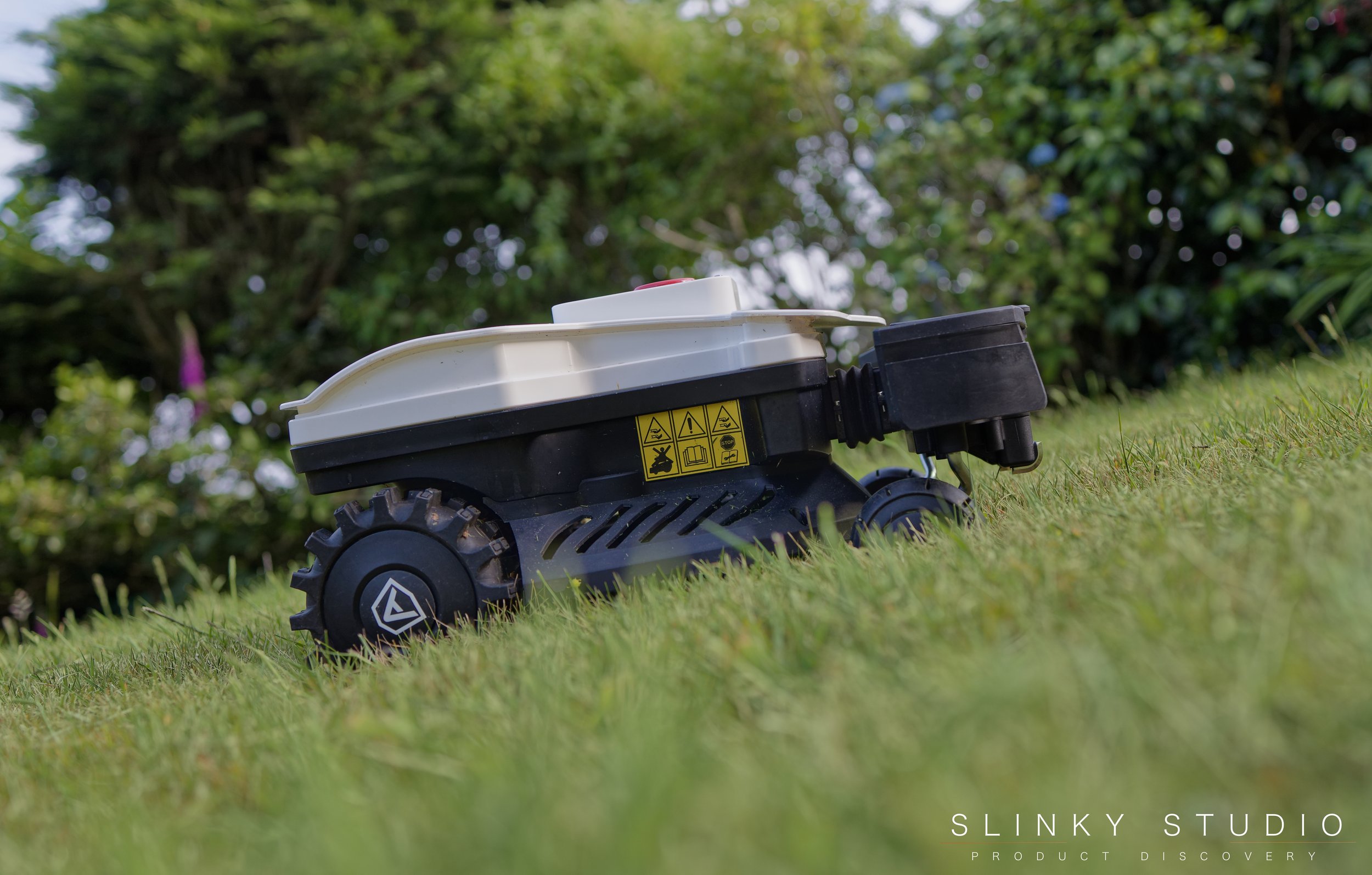
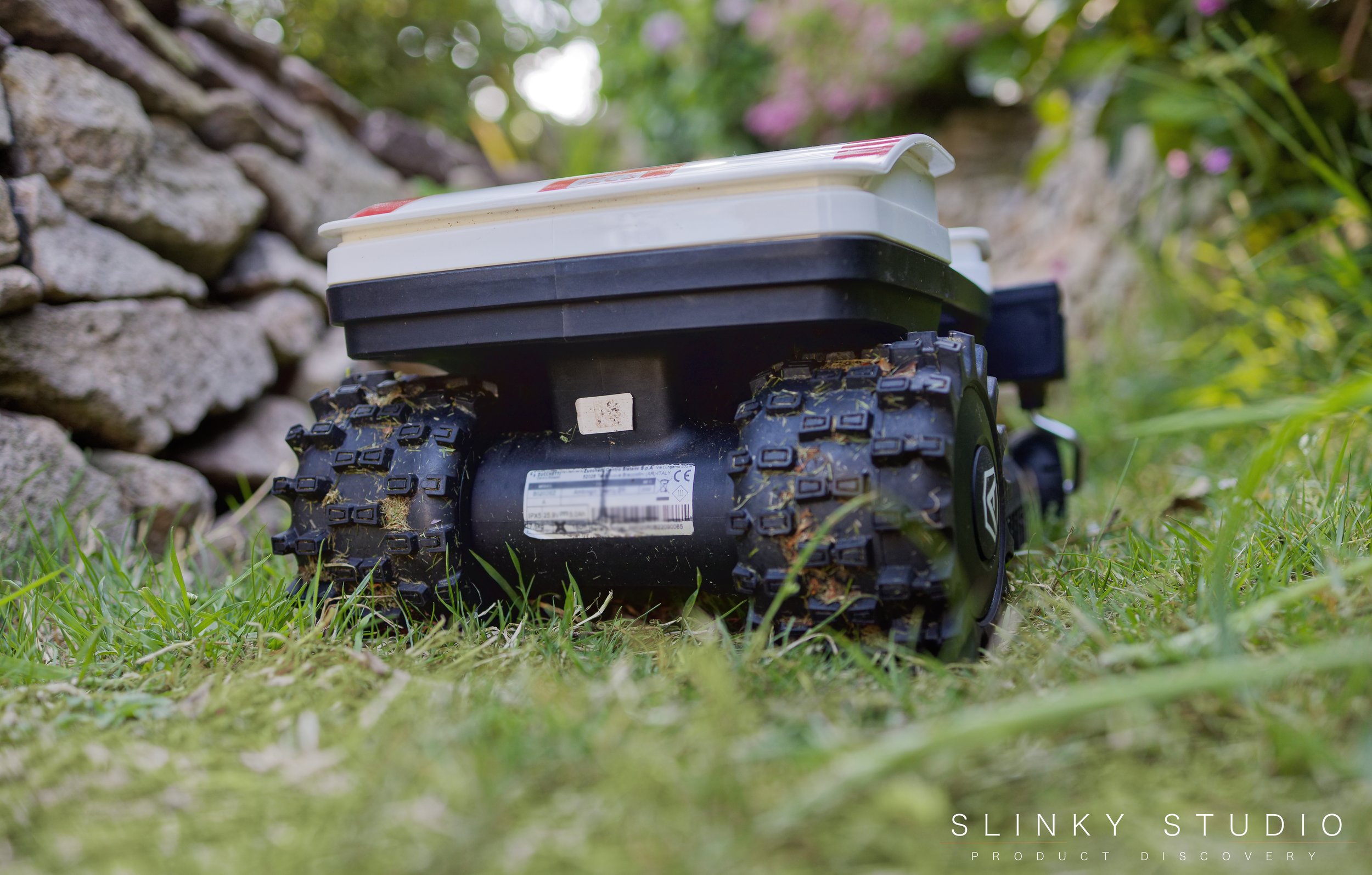
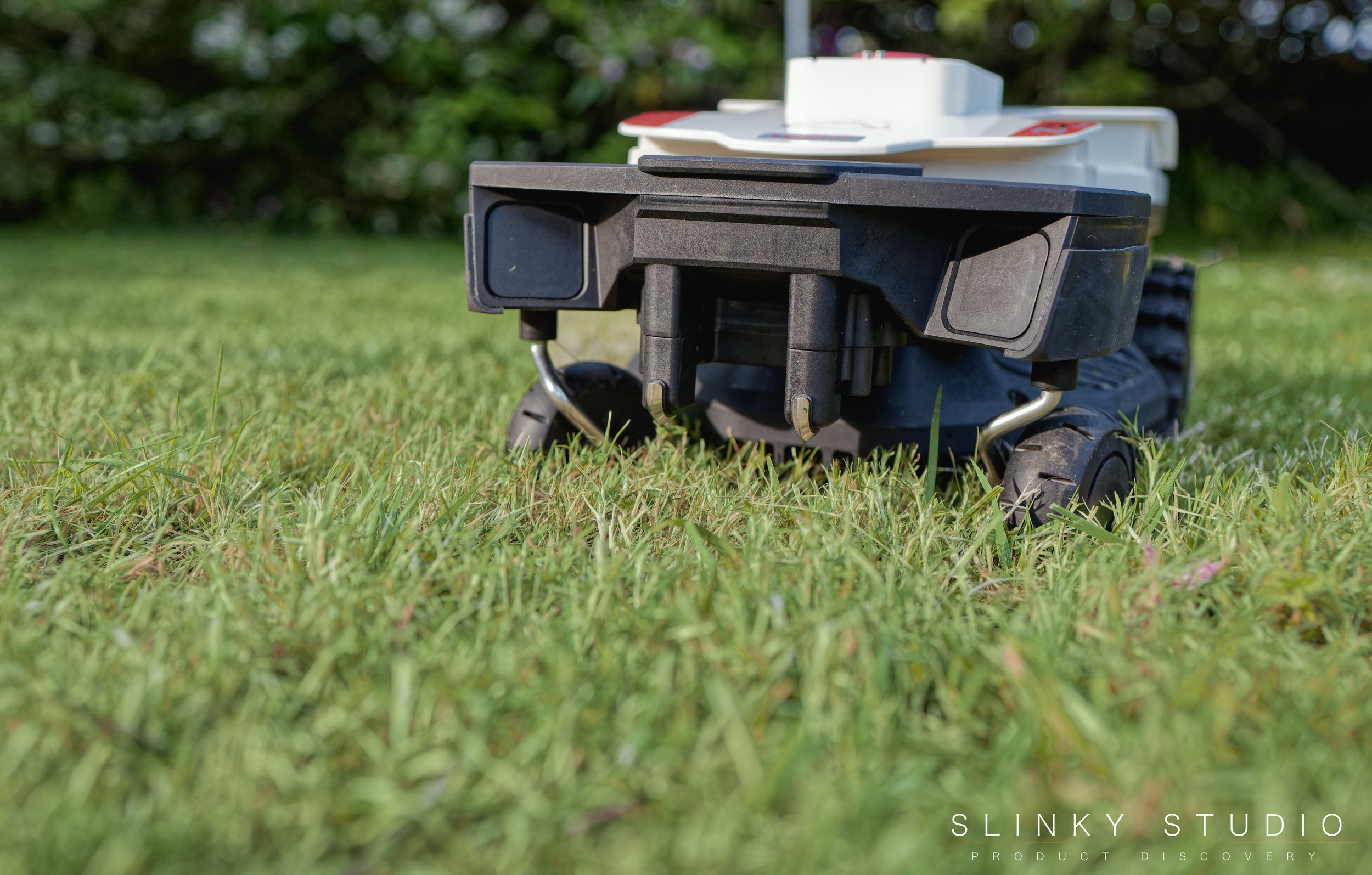
Cutting Performance
Upon introducing ZR to its main lawn, it was left to greet a wet week’s worth of growth. The grass was thick, 10cm in height, and and we knew it wouldn’t get like this again once we had scheduled a regular cut. So it was a good opportunity to see how well the cutting blade design and power produced from the brushless motor coped with such a task. Thankfully a targeted approach was automatically designated, therefore the Twenty ZR moved in a spiral pattern to tackle such areas with denser grass. This feature worked well enough, as the grass had to be cut from a tall cutting height with repeat path passes to embed finer cuttings into the lawn to leave a clean cut. The motor didn’t audibly stop at any point when we were observing it and just chugged along. In fact, it’s quiet in operation (we recorded it only being 60 decibels). Afterwards it was necessary to remove grass trimmings from the undercarriage, a task made easier due to the rubber seal.
General day to day scheduled mowing works well. We have it set to cut at 5cm length. The main lawn we have been mowing is anything but even and slopes downwards, yet the Ambrogio Twenty ZR robot lawnmower has been able to leave a well manicured lawn with no tyre indents. The independent front wheel tilting system assists the blade in cutting this uneven terrain, and because the rear wheels have real tyre treads, it travels easily across slopes of up to 35%, making them look fairly effortless. An interesting point worth raising, is that due to a recent few weeks of hot weather and a hosepipe ban, we would have had a slight pause in mowing if we had to do it manually ourselves as the grass is seemingly not growing. The truth is though, that shaded areas where water can be retained underground are still seeing a little growth and thus some blades of grass will shoot up amongst the yellow, so having the Twenty ZR pass over the lawn to give a uniform appearance is good. Additionally, as evidenced by all robotic lawnmowers we have ever used, that combination of regular mowing and the mower finely shredding clippings, provides natural regular fertilisation for a healthier, greener lawn.
Edge cutting isn’t quite as impressive here as with the Robomow offering that itself tackles one of the same lawns as the Ambrogio was tested on. The Twenty ZR is excellent and actually better at cutting an open edge which bleeds onto another surface, because it can identify what to cut and doesn’t need to be told. But despite its mower body getting as close as physically possible against edges where walls and boundaries are present, it leaves a few centimetres of grass that is untouched because the blade itself can simply not reach them. This means a grass trimmer is still a necessity for areas such as this.
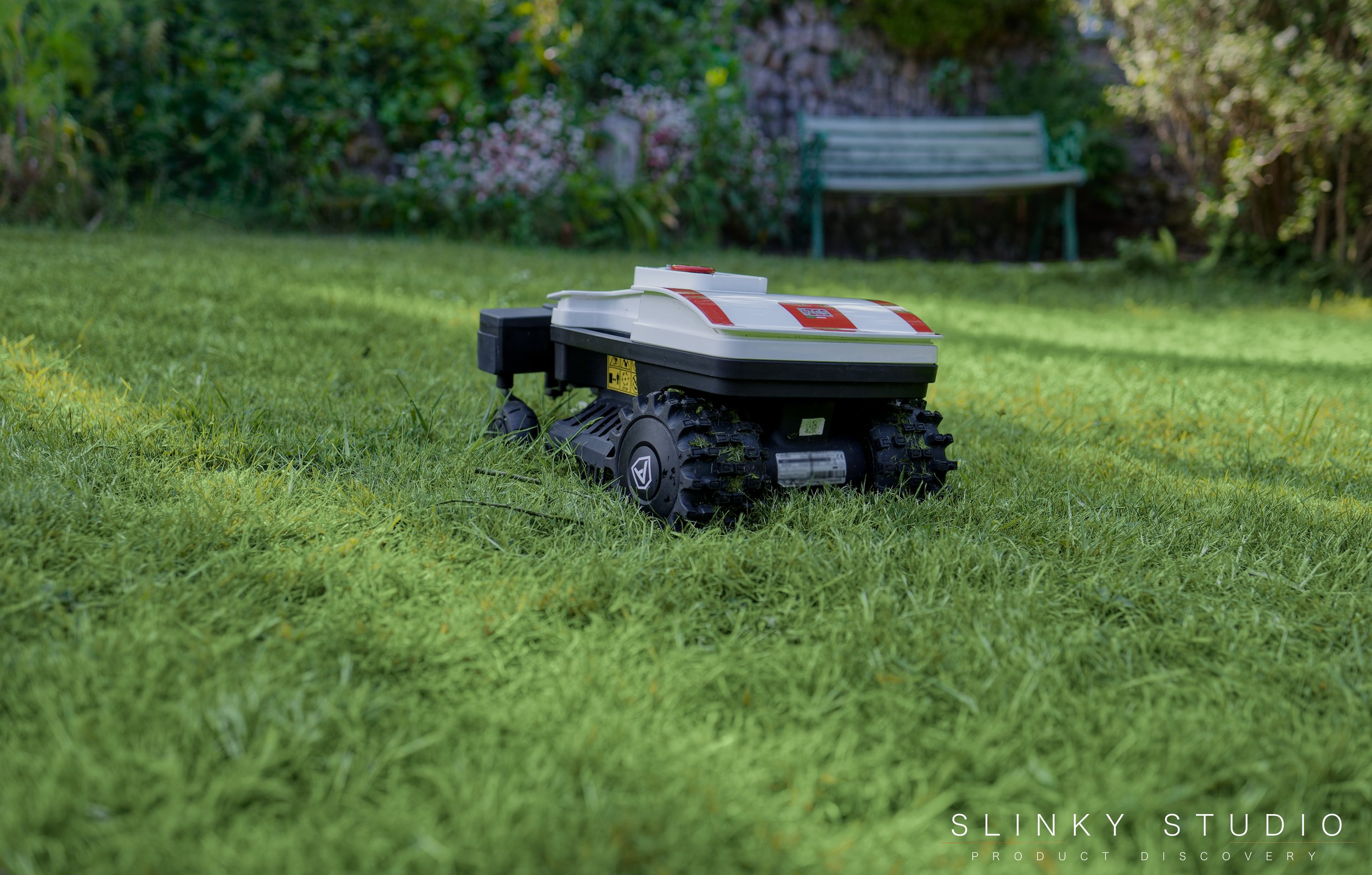
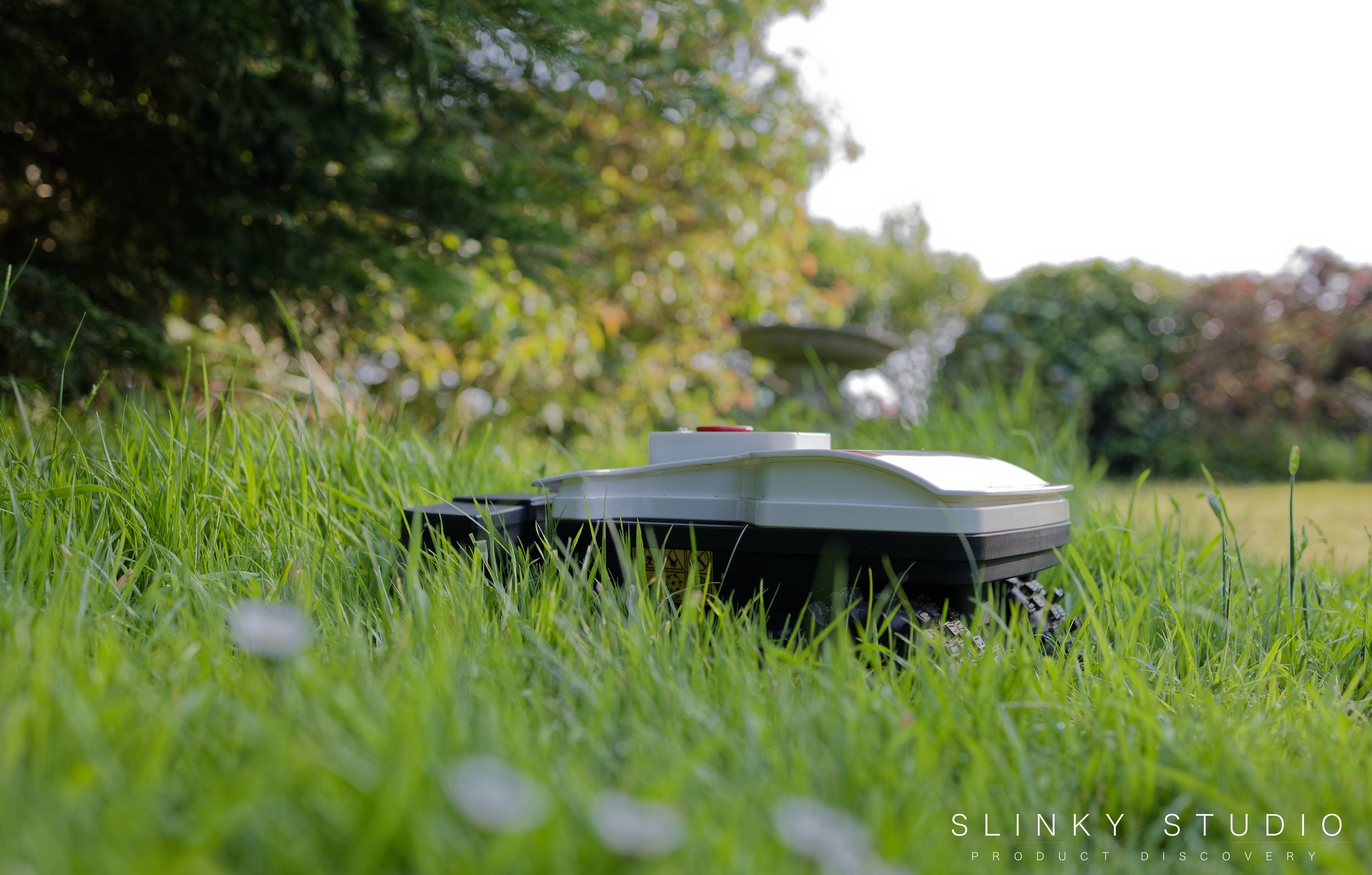
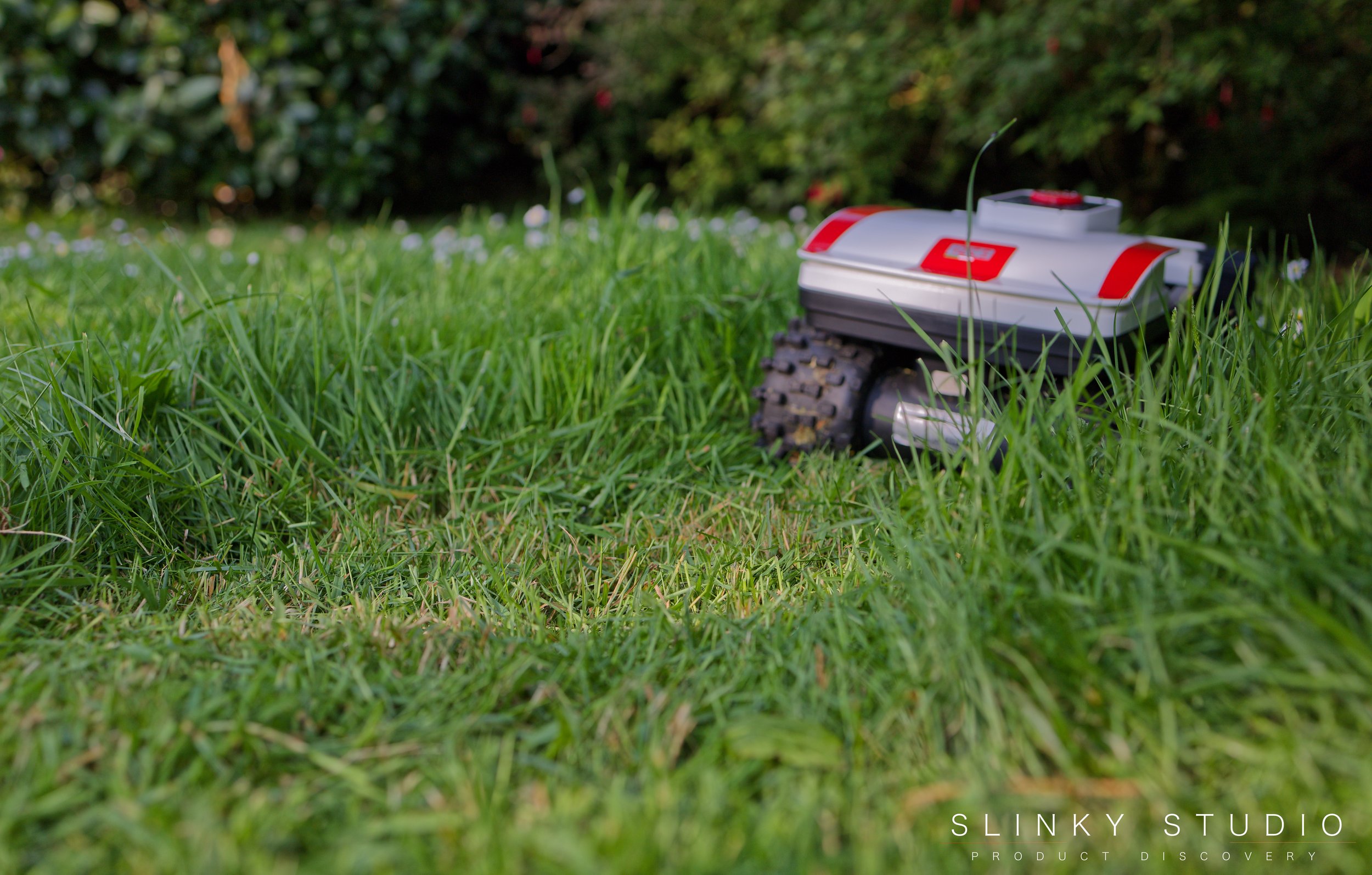
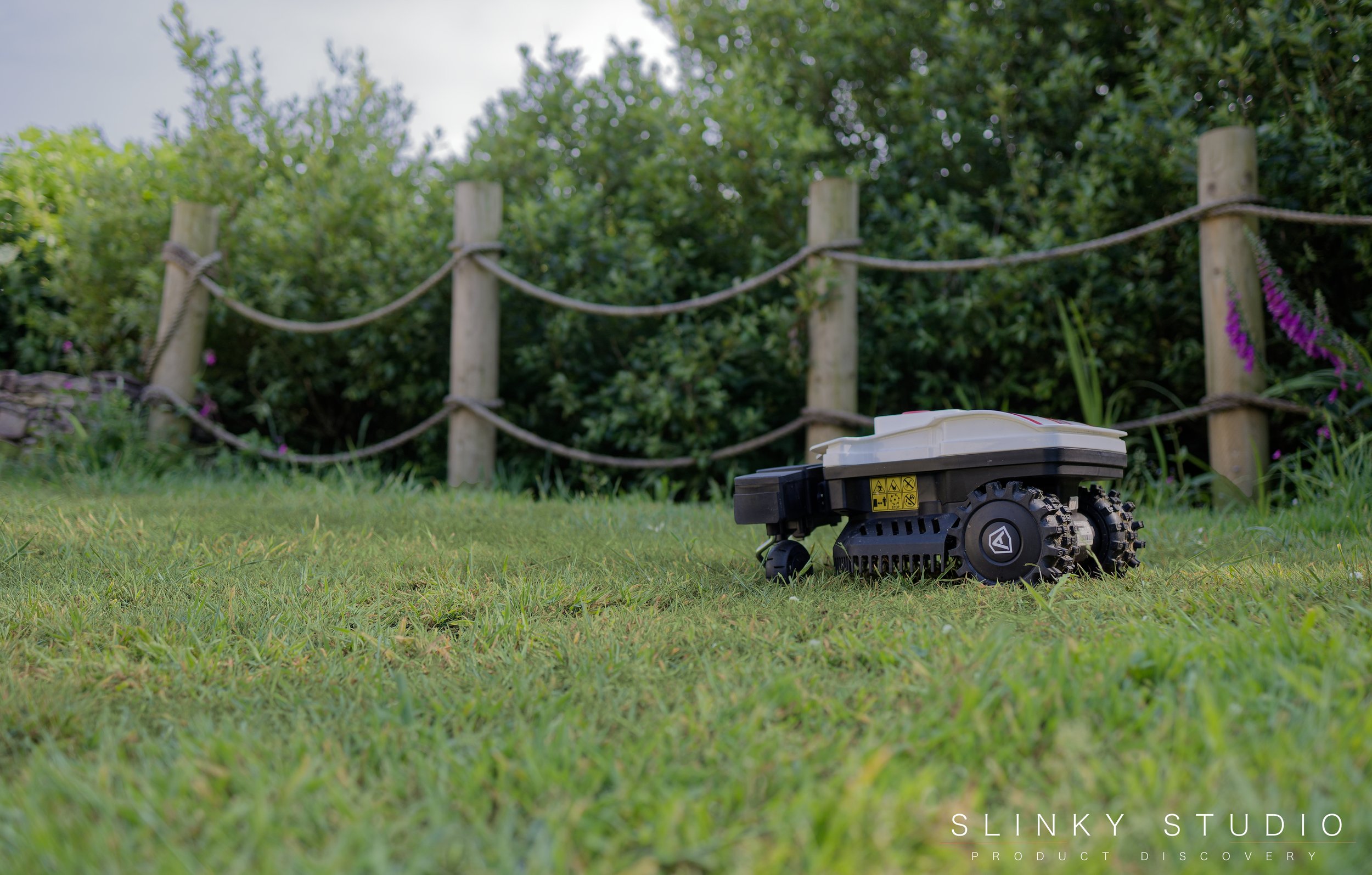
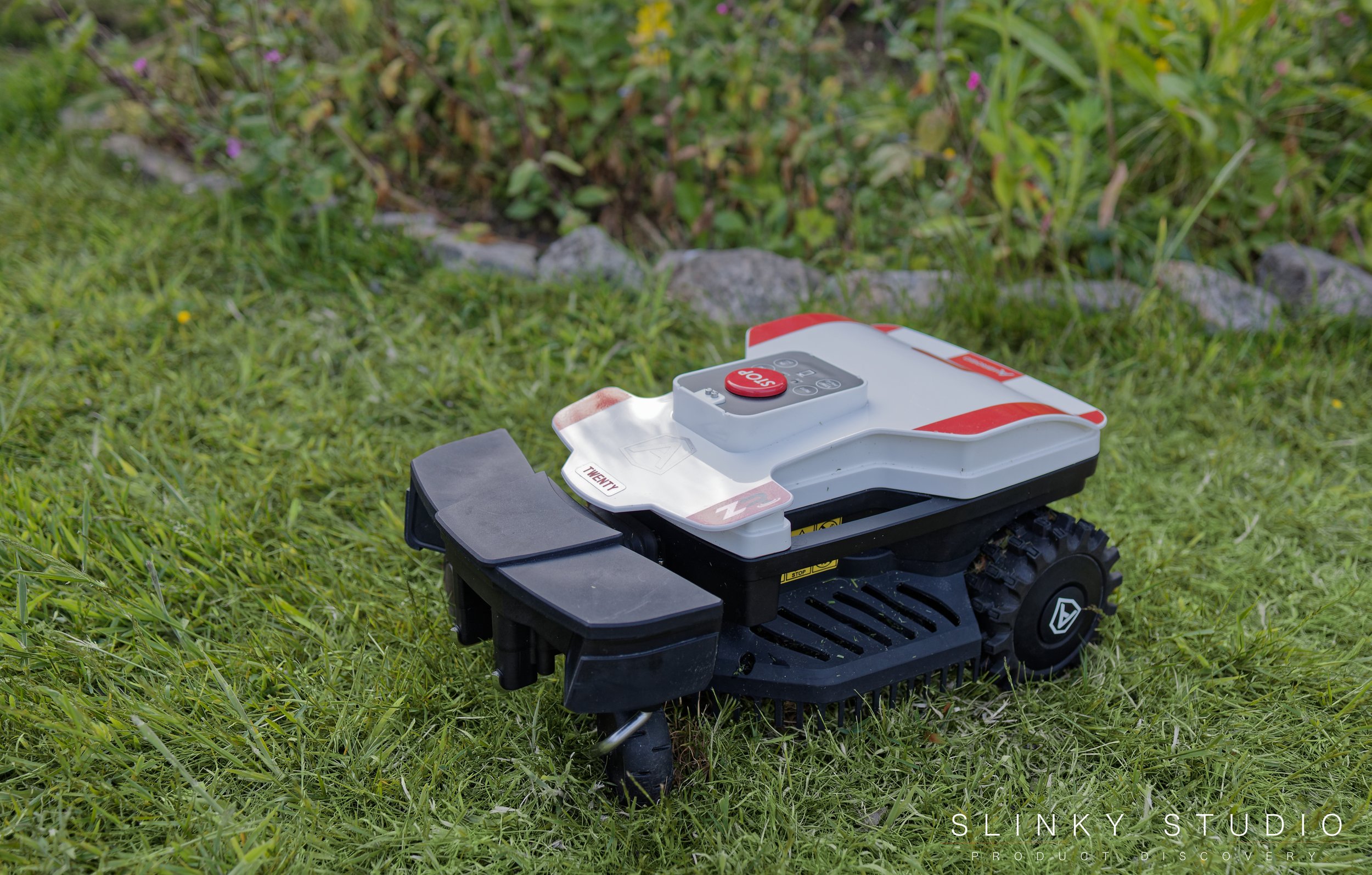
Verdict
Trust is paramount when considering a robotic lawnmower like the Ambrogio Twenty ZR, and after thorough evaluation, this has become a trustworthy wire-free autonomous mower companion. It offers an efficient and effortless cutting performance in all suitable areas where it has been tested up to 1000m². While there may be a few minor drawbacks, such as the app/device companionship not going as far as we’d like in yielding a smart-deviceesque window and the edge cutting performance against walls/hard edge surfaces, the overall intelligence and adaptability of the mower is truly remarkable. The Ambrogio Twenty ZR showcases its ability to effortlessly navigate and mow different lawns without the need for extensive setup. It handles challenging terrains with exceptional ease, demonstrating its reliability and competence. There is no doubt that it is a top contender in the competitive robotic lawnmower market.




